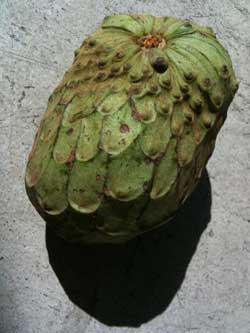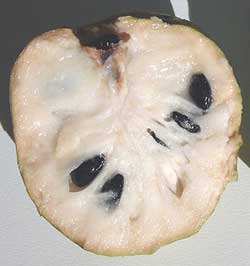Cherimoya


This strange looking fruit is called cherimoya, and is related to the Custard-apple. On the outside, it looks like a cross between an artichoke and a pear — green, scaly, and lightbulb-shaped. It has a few decent-sized seeds in its core that are easy to remove, and its white flesh is smooth. This is a fruit that Mark Twain supposedly called "deliciousness itself."
Native to the Andean-highland valleys of Chile, it is also cultivated in many places throughout the Americas, including California, where it was introduced in 1871, and Hawaii. In the Mediterranean, it is cultivated mainly in southern Spain (Granada and Malaga), Madeira, Lebanon, Egypt and Israel. The first planting in Italy was in 1797 and it became a favored crop in the Province of Reggio Calabria. It is also grown in Taiwan and New Zealand. In the UK, the Cherimoya is available from Spain from October to January
When shopping, look for large fruit which are uniformly green. Avoid fruits with cracks or mostly browned skin. Ripe fruit may be kept in the refrigerator, but it is best to let immature cherimoyas ripen at room temperature, until it yields to gentle pressure. When the fruit is soft-ripe/fresh-ripe and still has the 'fresh' fully mature greenish/greenish-yellowish skin color, the texture is like that of a soft-ripe pear and papaya. If the skin is allowed to turn fully brown, yet the flesh hasn't fermented or gone 'bad', then the texture can be custard-like. Often when the skin turns brown at room temperature the fruit is no longer good for human consumption. Also, the skin turns brown if it's been under normal refrigeration for 'too long' - a day or two maybe.
The sweet creamy flesh tastes of a sherbet-like banana, pineapple, pear, strawberry, cherry mix

